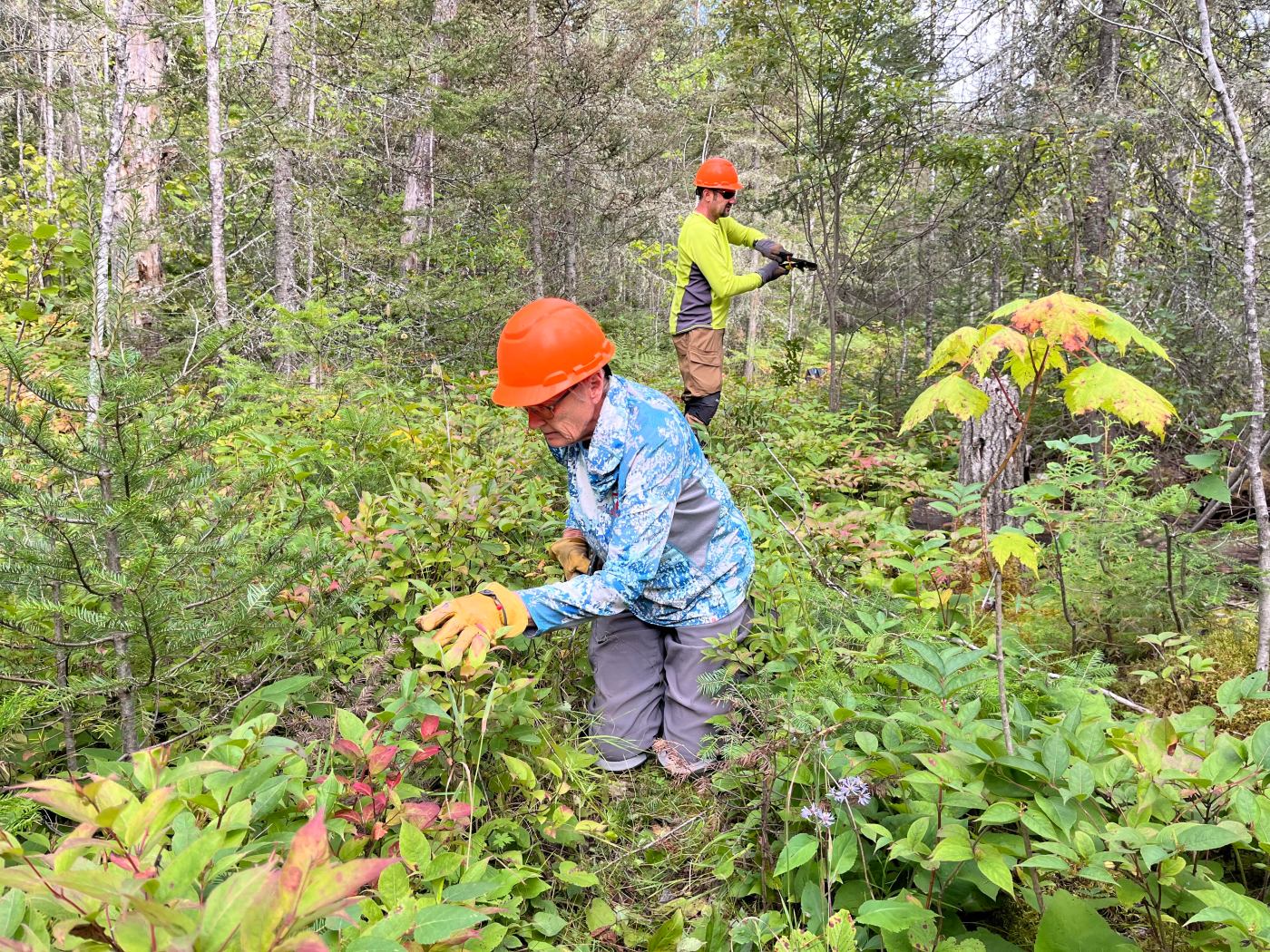
Want to try a Boundary Waters trip? This group will take you there — and put you to work.
Want to make a trip to the Boundary Waters Canoe Area Wilderness but you don’t have a crew?
The Boundary Waters Advisory Committee invites volunteers to join their crews on multiday trail-clearing journeys to make sure hikers in the northern Minnesota wilderness area can find their way through clear paths.
The Pioneer Press sent a reporter with little camping experience on a recent trail-clearing trip to get a taste of the wilderness and a feel for the work demands. Crew leaders demonstrated that there was plenty of valuable work to be done.
“These trails will not exist if volunteers are not doing what we’re doing,” said Mel Yackley, committee vice president and crew leader since 2020. “They’ll just go back to the forest.”
During the spring and fall months, the committee seeks volunteers 14 years old and up to join two- to five-day backpacking adventures in the wilderness forests. The trips consists of hiking the trails, clearing brush and fallen trees along the way, camping overnight and sometimes canoeing — all with the goal of making the trails more easily navigable than they were before.
Founded in 2002, the Boundary Waters Advisory Committee is a nonprofit focused on preserving the wilderness trails through advocacy, education and the hard work of the trail-clearing crews it organizes.
Yackley said the organization doesn’t often seek financial donations; most of their money goes toward purchasing tools, equipment and safety gear that last a long time.
“We honestly don’t need money, we need people’s time and energy, which is arguably more valuable than money,” she said.
Making the trip
Boundary Waters Advisory Committee president Lucas Raudabaugh explains how tools are used during trail clearings Sept. 7, 2024, on the Brule Lake Trail in the Boundary Waters Canoe Area Wilderness. (Talia McWright / Pioneer Press)
So what does a trip with BWAC look like?
Before heading up toward the Boundary Waters, crew leaders provide training to new volunteers, days in advance. They not only explain safety expectations, Forest Service agreements and regulations, they also occasionally host pretrip hikes and clearings in a nature area within the Twin Cities. Doing so allows new volunteers to get a taste of what the wilderness experience will hold.
“We really are made up of a lot of people who like mentoring and teaching,” Yackley said. “There is no silly question when it comes to anything we’re doing.”
The adventure truly starts with a five-hour (or longer) drive, which is typically a car pool amongst crew members. The first stop (aside from bathroom and snack breaks) is with the Forest Service, where the crew will watch an informational video about what to expect in the wilderness, grab a map and get any questions answered by staff.
Once parked near the trail, crew leaders hand out tools and safety gear such as helmets, work gloves, safety glasses, a whistle, knee pads, hand saws and loppers. The group will then review goals and expectations for the clearing.
Expectations are: stick together, always wear work gloves and safety glasses when handling tools, wear a whistle at all times (blow the whistle if you stray from the group and someone will blow one back and come find you), let the crew leader know if you need a break and everyone will take a break together, keep a wide arm’s length distance between people while working and yell out if a large cut tree is falling to prevent injuries.
“It really has become a well-oiled machine,” said Aaron Nosan, a crew member and leader since 2018.
On the trail
Boundary Waters Advisory Committee crew members and leaders, from left, Aaron Nosan and Mel Yackley, Lucas Raudabaugh and Robin Raudabaugh work to clear the Brule Lake Trail in the Boundary Waters Canoe Area Wilderness on Sept. 7, 2024. (Talia McWright / Pioneer Press)
After reviewing expectations, the crew begins hiking toward the trail that needs clearing, often passing by photo-worthy things such as moose tracks (if you’re lucky you might even see a moose).
Once at the trail, the crew covers the length in sections, keeping safe distances from one another. Crew leaders demonstrate how tools are used.
Trees and brush that are cut from the trail are then stacked in a pile for the designated “swamper” to take away and hide in the forest, with the cut ends facing away from the trail to appear as natural and untouched as possible.
“We’re trying to make it look like we were never here,” committee president and crew leader since 2017 Lucas Raudabaugh said.
There are breaks for lunch, snacks, water and, of course, backwoods bathroom breaks as needed.
Over a weekend trip on Sept. 7-8, the crew started work on the trail at noon and stopped at 5 p.m. after clearing one-third of a mile of the Brule Lake Trail.
Well-deserved rest
Boundary Waters Advisory Committee team members and volunteers set up camp on Sept. 7, 2024, on the Brule Lake Trail in the Boundary Waters Canoe Area Wilderness. (Talia McWright / Pioneer Press)
After a long drive and hard half-day’s work, the crew set up tents at a campsite and expert fire starter Nosan lit one for team members to gather around.
Nosan recalls being disappointed after hearing how much of the trail his crew cleared during his first trip in 2018. He hadn’t known that the 0.3 miles of progress they made on the trail was a good thing until crew leaders celebrated.
Related Articles
Heavy June rains put a damper on ruffed grouse hunting prospects
St. Paul scouting troop to celebrate 100th anniversary with reunion
Snorkeling in South Florida: Check out these 6 must-see spots
Fall arts and entertainment guide: Get outside and stay creative with these fall festivals and family fun
Skywatch: The delightful celestial dolphin
“What I’ve learned is, inexperience is OK … and we really do take pride in making sure that all expectations are explained as well as we can up front, so that way nobody has any surprises,” Nosan said.
Though Yackley had hiking experience prior to joining the committee in 2020, she said that on her first clearing, she thought she wasn’t qualified for the task.
“It turned out I’m fully capable and I didn’t need any experience,” Yackley said. “People don’t need experience to come clear on trail. Honestly, 90 percent is attitude.”
Raudabaugh’s mother, Robin, a farmer and avid nature explorer, experienced her first trip that weekend and said although she was a little nervous at first, she enjoyed clearing the trail. The crew celebrated her 69th birthday at the campsite with her favorite guilty-pleasure snack, Little Debbie’s Nutty Buddies. A lighter served as a substitute for birthday candles.
“I’m looking at my calendar and seeing if I can come in October,” she said with laughter.
Wildfire cleanup
Partnered with the Forest Service, the committee has a volunteer agreement to work on any trails in the Boundary Waters.
In 2011, the Pagami Creek Wildfire burned the entirety of the Powwow Trail. The organization was committed to working with the Forest Service to restore the trail and was approved in 2015 to begin the work.
Nosan said when he joined in 2018, the devastation of the fire damage to the Powwow Trail was still visceral. He said the lack of animal sounds was eerie.
In 2022, the committee cleared the 30-mile loop and deemed it fully passable. Nosan said over the years, wildlife has begun to return as has new tree growth, which has brought him excitement.
Other trails the committee works on include the Sioux Hustler and Brule Lake/Eagle Mountain trails.
“BWAC is situated to help out in the future when needed,” Raudabaugh said.
How to participate
Raudabaugh said a work-in-progress initiative for the committee is to diversify the volunteer demographic. He said the Boundary Waters often has been used more by people who have financial wealth. Raudabaugh said they try to break these barriers by providing gear and mentoring.
Some fall trips still have room for volunteers.
Upcoming trips include backpacking on the Powwow Trail from Sept. 27-30, hiking to Superstition Lake from Oct. 11-14 and backpacking on the Powwow Trail from Oct. 17-20. Another series of trips will be announced for spring 2025.
For more information, visit boundarywaterstrails.org.
Gear list
Here are some trail-clearing trip necessities and niceties, according to Boundary Waters Advisory Committee participants:
Water-carrying capacity of 3 liters.
Closed-toe shoes/boots.
Rain gear (poncho, jacket, pants).
Tent.
Sleeping bag.
Sleeping pad (for extra comfort).
Spoons, spoons, spoons (you’re going to need them).
Tiny stove nested in two pans.
Colorful wool socks for sleeping.
Foldable chair for campsite.
Related Articles
St. Paul’s Victoria Theater, a former silent theater, reopens as 825 Arts center
St. Paul scouting troop to celebrate 100th anniversary with reunion
10,000 Lakes Concours d’Elegance returns after 5 years — and a Stillwater couple has just the car for it
‘Field of Bands’ fundraiser to aid veterans and troops
Black and Latina-owned businesses receive $2M in funding from St. Paul nonprofit

